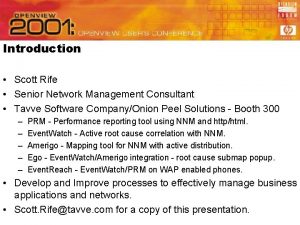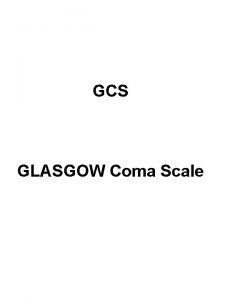Scot Grid Glasgow Site Update Dr Emanuele Simili




















- Slides: 20

Scot. Grid Glasgow - Site Update Dr. Emanuele Simili 24/05/2019 @ HEPSYSMAN

Outline - Glasgow site capacity & performances Current Cluster & Network Upcoming Data Center New cluster & new network prototype HTCondor-CE (brief experience) CEPH (by Sam) Documentation & Inventory Scot. Grid Glasgow: Gareth, Sam, Gordon + me (Emanuele) me: NOT an IT expert, but ex physicist, teacher, programmer … my role: learn, ask questions, organize the information Wiki! (see last slide)

UKI-SCOTGRID-GLASGOW • Part of the Grid. PP collaboration providing resources to the Worldwide LHC Compute Grid (WLCG). • One of 19 institutions comprising 4 distributed Tier-2 sites (SCOTGRID, NORTHGRID, SOUTHGRID and LT 2). • Part of the SCOTGRID Distributed Tier 2 including Glasgow, Edinburgh and Durham Universities.

Our Current Capacity • At present consist of: • 4864 CPU cores (with 1000 core uplift by end if 2016) • 7, 348, 500 MB of RAM • 2. 4 PB of Storage (with 0. 5 PB being commissioned) • 160 Gb/s internal network bandwidth

Site Performance We support large VOs via the standard ARGUS/ARC architecture.

VACs We continue to run VAC, which are exceedingly useful to support small VO.

Cluster Map

Network Map new network All IPs refer to the internal network configuration. current network

Data Center pics The new data center is being completed and we hope to move the first servers in July …

Data Center Prototype We have built the first prototype of the new Data Center by re-furbishing 2 racks with: - brand new DELL 440, 640 & 740 servers, - 3 recycled HP Pro. Liant worknodes, - 1, 10 & 40 Gb switches. And we have installed: - provisioning server, - VM Hypervisor (Prox. Mox cluster), - HTCondor batch system, - CEPH storage, - networking (DNS, DHCP, NAT), - services. (see details on the next slides)

New Cluster These are the machine and switches installed in the two new racks.

New Internal Network - 4 separate VLANs dedicated to different purposes - fresh set of IPv 4 addresses which will be assigned following some rules

VM Hypervisor The Prox. Mox cluster is composed of 3 DELL 440 servers. It works great, was easy to install and configure, and it is already running several VMs dedicated to various services (see tables):

New HTCondor Cluster From 3 recycled HP Pro. Liant machines (decommissioned from the old cluster) we have built the new HTCondor batch system prototype (Cent. OS 7). We have done the provisioning with the new Ppe. Pixie, and wrote Ansible roles for the complete set-up of Worknodes and Manager (repositories, packages, configuration). A default user has been created and the HTCondor batch system was then tested with the Eratostene’s sieve to find prime numbers … so far so good.

HTCondor-CE Attempt We investigated deployment of an HTCondor-CE, using details from Steve Jones (see Grid. PP talk) and the OSG documentation … No documentation was an exact match for our set-up: multiple CEs (four at present), with a separate central manager. In particular, the configuration of security between the CE and the manager proved tricky (it might be easier if we turned all security off, but we’re reluctant to do that!). We still have a lot of work to do prior to our impending Data Center, which restricts the amount of time we can spend. Plus, it appeared there would be a lot of background research to do in areas of Condor we’re not familiar with before we became comfortable with the system. So … we have decided to stick with ARC CEs at the moment, as we are familiar with the configuration and have confidence in the technology. We will revisit HTCondor. CEs at a later stage, when we have a bit more time and experience!

CEPH cephc 0{1: 2} 6 x 1 Tb SSD Ceph Pool (rados pool) cephd 0{1: 8} 20 x 10 Tb HDD cache tier 6 x OSD EC tier EC stripe: 10+2 (standard reed-solomon encoding) [new in nautilus EC module “CLAY” looks awesome but never adopt bleeding edge tech! ] 20 x MON 20 x OSD • Basic config for ceph pool at GLA • Config via ceph-ansible [which has some quirks if you use the Centos 7 Storage SIG Repo, as there’s one or two odd packaging dependencies] • Plus: xrootd, gridftp daemons using libradosstriper for data placement and access. • libradosstriper splits incoming files into stripes of uniform chunks (chunk size is invariant) – chunks are then EC coded into stripes in the EC tier.

CEPH (2) • Differences to RAL • RAL caching is in xrootd / per WN • Reconstructs entire libradosstriper stripe + caches file • Caches are local to WN (so less shared cache efficiency) • GLA caching is in ceph cache tier / per pool • Reconstructs EC stripe + caches libradosstriper chunks • (There’s still a reconstruction overhead per libradosstriper chunk for accessing entire file) • Caches are shared for entire cluster (better shared cache efficiency) • Plan A – as in these slides, ATLAS space entirely in ceph (migrate our other Nx 10 TB disk nodes also into the ceph pool) • Plan B – add cephfs “posix” layer on top, export as “neoclassical SE” • Plan C – try EOS (without EC as EOS EC performance is ? poor? , so efficiency loss) For any question related to Storage and CEPH, please ask Sam

Documentation Cluster information and administrative procedures (for technicians) are being organized in a shiny Doku. Wiki format. Information such as: - cluster & network map, - list of machines (inventory), - services status. http: //dokuwiki. beowulf. cluster/ Procedures such as: - routers configuration, - servers provisioning, - VMs creation, - services set-up. Since the information is very site-specific (and security-sensitive), these pages are currently available only to us (Glasgow). But we are ready to share our procedures and Ansible roles to whoever asks.

Inventory Tool A useful tool I have developed at the very beginning of my contract is a sort of inventory script, which uses Ansible to collect information from all machines on the cluster and python script to organize them in a CSV file. The procedure is easy to run and can be done every month to keep the machine inventory up to date. The starting point is anyway the ansible inventory, which need to be maintained by hand - unless you wanna play with nmap and dig and try to blindly re-map the whole network (a futile exercise which I have also done …). Show the latest update: inventory_v 6 x. xlsx

Scot. Grid Glasgow - Site Update END Dr. Emanuele Simili 24/05/2019 @ HEPSYSMAN
 Deferred update and immediate update
Deferred update and immediate update Monomio per polinomio
Monomio per polinomio Monomi simili
Monomi simili Triangoli simili
Triangoli simili Using similes and metaphors in descriptive writing
Using similes and metaphors in descriptive writing Simili
Simili Metodo chou fasman
Metodo chou fasman Immagini visivamente simili
Immagini visivamente simili Luigi altavilla
Luigi altavilla Quando due poligoni si dicono simili
Quando due poligoni si dicono simili Radicali simili definizione
Radicali simili definizione Scot model
Scot model Mail.sap.corp
Mail.sap.corp Scot rife
Scot rife Sheana bull
Sheana bull Scot zarkiewicz
Scot zarkiewicz Simd postcode lookup 2020
Simd postcode lookup 2020 Scot pho
Scot pho Scot pho
Scot pho Global scot
Global scot Wcot and scot column difference
Wcot and scot column difference






































